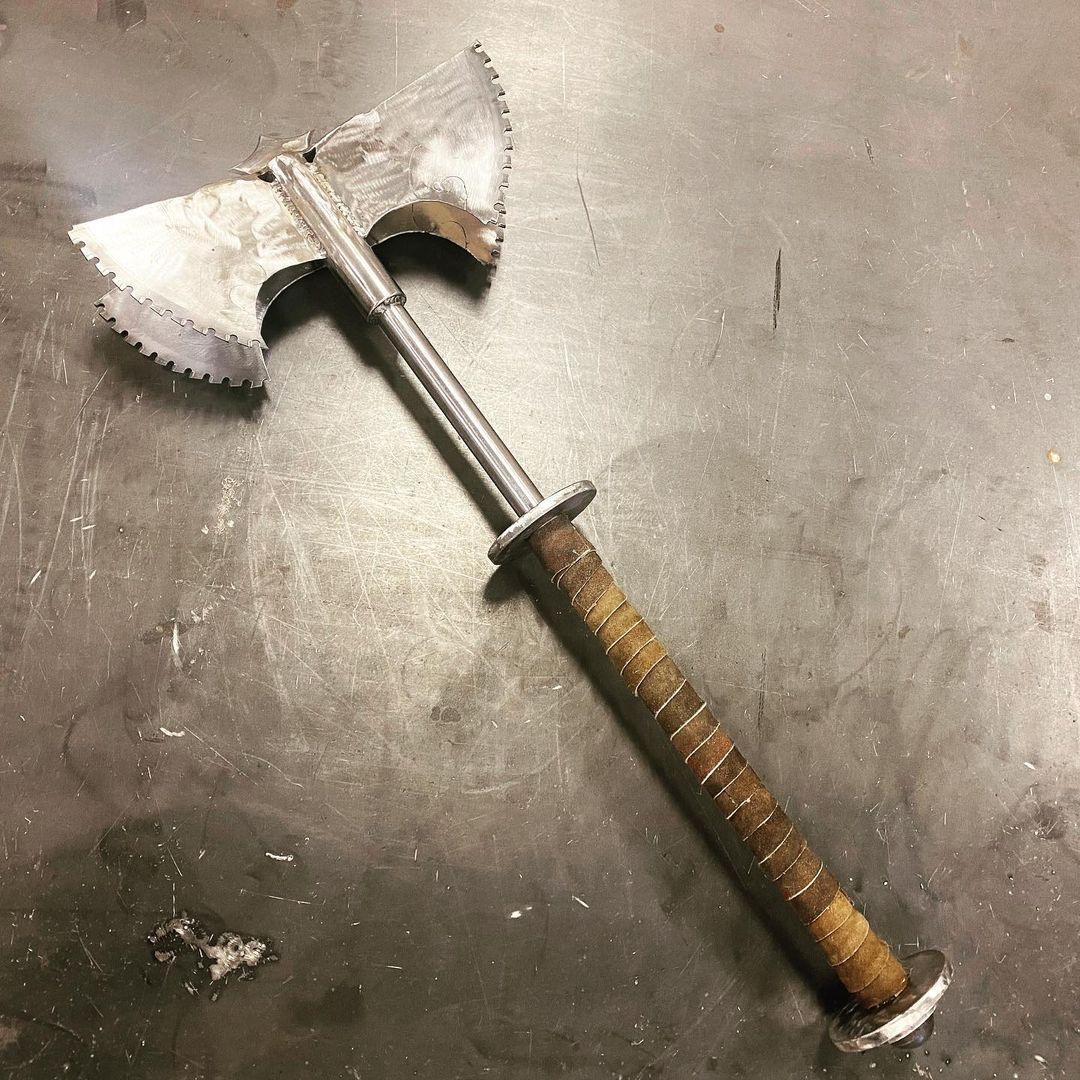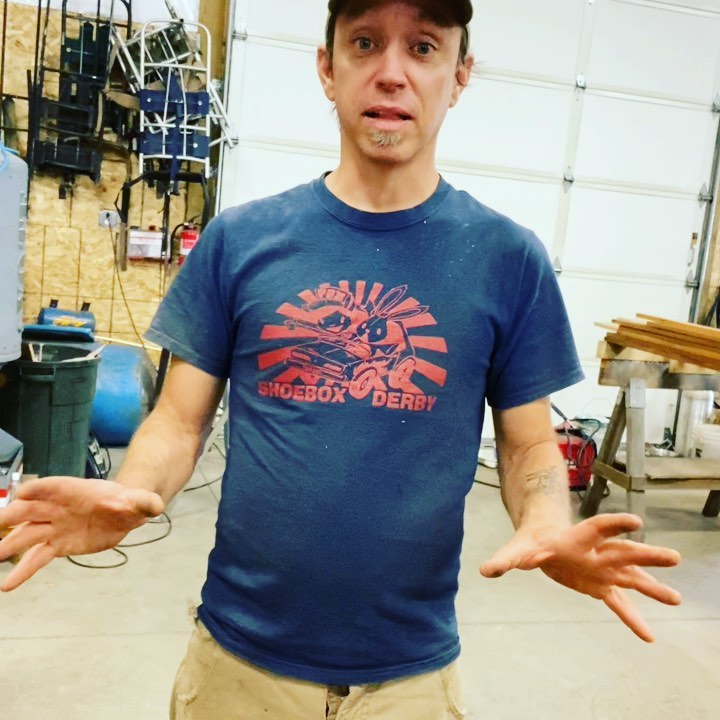Here is the second entry in my line of Zombie Defense Weapons. This one features a padded reclaimed leather handle, custom ‘quad-blade’ makes from reclaimed saw blades, and what I’m calling a “King’s Crown Cap.” All materials were items that were lying around my shop. Hopefully this weapon will never need to be used, but if the day comes that the zombies actually take over, you’re gonna want this by your side. Available for sale. #tylerfuquacreations #zombie #weapon #zombiedefense
BLOG
U.S. National Deadline: September 15, 2022 – In response to the ongoing climate crisis, BMAC has created an artist residency program to support artists seeking time and resources to engage with the profound…
“Just as no two artists are alike, every arts community is defined by a distinct matrix of identities, perspectives, histories, and economic conditions,” said former GIA board chair Ted Russell, and Lu Zhang. “In order to be successful at any level, arts funding must respond to these conditions. This is why our organizations teamed up to create The Rainin Fellowship, a program tailored for the arts communities of San Francisco’s Bay Area (the home of the Kenneth Rainin Foundation), developed alongside United States Artists, which has supported artists across the country for nearly 20 years.”
“By supporting anchor artists, the Rainin Fellowship aligns with and preserves this unique history, which is just another thing we risk losing if artists are not properly supported. At every moment in our history, the arts and artists have played an integral role in these social movements, including the Berkeley Free Speech Movement and the American Indian Power Movement. But in a time of crisis, stoked by forces of displacement, gentrification, and inflation that are pushing out the constituents of these social movements, the urgency of our challenge becomes clear: How to preserve our communities, and culture, and how to do it swiftly, and sustainably? One answer, we have found, is to support the artists at the centers of these movements, allowing them to keep making work in their communities.”
“From audience engagement to storytelling, institutional critique to social activism, the 2022 Fellows represent various ways that artists affect their communities far beyond what was once considered to be the role of art. This fellowship structure of direct support matched with additional stipends aimed at supporting artists holistically, works for the Bay Area community, but can also be replicated in other communities across the country. And that’s the moment this becomes a national model.”
“Nonprofit organizations pledge to serve communities through powerful missions. Often, those missions are around empowerment, restoration, safety, and wholeness for the marginalized within our communities. The past two years of racial reckoning has led the nonprofit sector to examine the ways in which white supremacy lives in our organizational systems,” said Nonprofit Quarterly author Sequoia Owen. “Increasingly, nonprofits are publicly showing support for Black causes—at times, to distance themselves from the appearance of condoning racism. Operating as pro-Black, however, involves much more than releasing a statement of support for Black and Brown lives. It may not even require a change in organizational mission or new programming—an organization can make such changes and still operate with a white supremacist structure.”
“Being a pro-Black organization means internalizing our missions and extending energy and resources to our frontline staff who serve our communities. It calls for the antithesis of divisiveness and destruction and a movement of restoration. Nonprofit leadership must build thriving workplace environments in which staff have the permission and tools they need to become their best selves. A pro-Black organization ensures staff wellbeing, safety, dignity, and advancement by practicing trauma-informed, collective care, prioritizing psychological safety, and restoring worker dignity by providing equitable living wages and building leadership pipelines.”
Here is an update for our newest robot, Mechan H2O. #tylerfuquacreations #mechanh2o #mechan_inc #mechan9 #pompanobeach #giantrobot
Once again Portland will be lit up in February with the Portland Winter Light Festival! Come check out our installation, “The Window of Illusion!,” downtown at SW Morrison and SW 9th. The event goes from Feb 4th to the 12th. Check out www.PDXWLF.com for a map and all the other info! #pdxwlf #tylerfuquacreations #trippywindow #chromadepth #pdxwlf2022
The Portland Winter Light Festival is this weekend! www.PDXwlf.com Come check out our Window Of Illusion at SW Morrison and SW 9th! #tylerfuquacreations #pdxwlf
The more that we learn about the creations of our ancestors, the more we connect ourselves to the past. From the excavation of a striped tunic in Egypt that mirrors children’s shirts of today to the discovery of hand prints left upon ancient walls that show a universal desire to leave a mark upon the world, we gain insight from what is left behind. One of the most recent finds of note is an immaculately preserved wooden sculpture in Chan Chan, Peru.
Chan Chan, while not necessarily still considered a city, was the largest pre-Colombian city in South America. The second-largest city constructed from adobe in the world, Chan Chan (literally meaning “Sun-Sun” but perhaps translating to “Great-Sun”) was constructed in 850 CE along the Moche Valley, serving as the capital of the Chimor empire. It was known for its elaborate citadels (Ciudadelas) which were large, intricately designed structures to house mercantile areas and burial sites for the royals. These lavish pieces of architecture are prime evidence of why the former city has become a devoted excavation site since 1986.
In the continued excavation of Chan Chan, the Culture Ministry of Peru announced at the end of June the discovery of a perfectly preserved wooden sculpture, which they state is one of the oldest discoveries found at the site. Apparently depicting a ruler’s litter bearer, there is still a great deal of vibrancy to the depiction. From the terra cotta skin to the bold red nose and the black almond eyes—where mother-of-pearls would have been affixed—there is life and energy still felt in this centuries-old carving.
The director of the Chan Chan Archaeological Complex Special Project César Gálvez Mora stated that “the finding adds to significant evidence that ratifies the ceremonial function of a building peripheral to Chan Chan,” and goes on to express how this discovery enriches Chan Chan as a World Heritage Site.
Headquartered in Atlanta, Georgia, South Arts is a nonprofit regional arts organization empowering artists, organizations, and communities, and increasing access to arts and culture. In partnership with the National Endowment for the Arts and the State Arts Agencies of Alabama, Florida, Georgia, Kentucky, Louisiana, Mississippi, North Carolina, South Carolina, and Tennessee — with additional funding from other public and private donors such as the Doris Duke Charitable Foundation, the Ford Foundation, and The Andrew W. Mellon Foundation — South Arts supports artists and organizations through a rich and responsive portfolio of grants, fellowships, and programs.
South Arts believes in the power of the arts crossing borders. Their region birthed jazz, cultivated the traditional arts of Appalachia, and is home to some of today’s most innovative, boundary-pushing artists. Past, present, and future, the arts of their region drive the country forward. South Arts supports and celebrates the artistry of their region with grants and fellowships for artists, communities, and organizations. From the most rural and isolated towns to our largest urban cities, communities thrive with access to art. They support organizations that present and engage touring Southern artists for performances, readings, exhibits, and residencies. South Arts values partnerships between artists and organizations that cross sectors, impacting areas of life including healthcare, aging, and education.
On July 6, 2022, South Arts announced 17 organizations selected as Southern Cultural Treasures, a $6,000,000, multi-year initiative supporting Black, Indigenous, and People of Color (BIPOC) -led and -serving arts and cultural organizations throughout the Southeast. With lead support from the Ford Foundation and modeled after their “America’s Cultural Treasures”, this program aims to acknowledge and honor the diversity of artistic expression and excellence in America and provide critical funding to organizations that have made a significant impact on their communities’ cultural landscapes. Under the leadership of South Arts’ Vice President of Programs, Joy Young, PhD, the program runs through March 2025 and provides each organization with up to $300,000 of general operating grants, an additional project grant of up to $7,500, customized consultant services, networking, cohort building, and knowledge sharing. Southern Cultural Treasures is designed to be a measure of sustainable support. By providing BIPOC-led and -serving organizations with tools and frameworks to establish their own agency and institutional narratives, the initiative encourages growth throughout the South—not only in the context of the arts, but also in the impact of surrounding communities as well. The 17 Southern Cultural Treasures are: Alabama Jazz Hall of Fame (Birmingham, AL), Art2Action (Tampa, FL), Ashé Cultural Arts Center (New Orleans, LA), Asia Institute – Crane House (Louisville, KY), B.B. King Museum and Delta Interpretive Center (Indianola, MS), Ballethnic Dance Company (East Point, GA), Catawba Nation Cultural Division (Rock Hill, SC), Collage Dance Collective (Memphis, TN), Colour of Music Festival (Charleston, SC), Deep Center (Savannah, GA), Diaspora Vibe Cultural Arts Incubator (Miami, FL), JazzArts Charlotte (Charlotte, NC), Junebug Productions (New Orleans, LA), Mississippi Center for Cultural Production (Utica, MS), Otis Redding Foundation (Macon, GA), Teatro Avante (Miami, FL), and True Colors Theatre Company (Atlanta, GA).
You can also visit the South Arts photo gallery on GIA’s Photo Credits page.
Photo by Mariana Sheppard / Junebug Productions.





